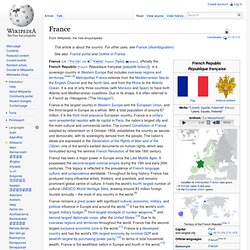

Departments of France. In the administrative divisions of France, the department (French: département, pronounced: [depaʁtəmɑ̃]) is one of the three levels of government below the national level ("territorial collectivities"), between the region and the commune.

There are 96 departments in metropolitan France and 5 overseas departments, which also are classified as regions. Departments are further subdivided into 342 arrondissements, themselves divided into cantons; the latter two have no autonomy and are used for the organisation of public services and sometimes elections. The departments were created in 1791 as a rational replacement of Ancien Régime provinces in view of strengthening national unity; almost all of them are therefore named after rivers, mountains or coasts rather than after historical or cultural territories, unlike regions, and some of them are commonly referred to by their two-digit postal code number, which was until recently used for all vehicle registration plates.
History[edit] Regions of France. France is divided into 27 administrative regions (French: région, pronounced: [ʁe.ʒjɔ̃]), 22 of which are in Metropolitan France, and five of which are overseas.

Corsica is a territorial collectivity (French collectivité territoriale), but is considered a region in mainstream usage, and is even shown as such on the INSEE website.[1] The mainland regions and Corsica are each further subdivided into departments, ranging in number from 2 to 8 per region for the metropolitan regions; the overseas regions technically consist of only one department each. The term region was officially created by the Law of Decentralisation (2 March 1982), which also gave regions their legal status. The first direct elections for regional representatives took place on 16 March 1986.[2] General characteristics[edit] Role[edit] Regions lack separate legislative authority and therefore cannot write their own statutory law. A region's primary responsibility is to build and furnish high schools.
Left Right. Administrative divisions of France. The administrative divisions of France are concerned with the institutional and territorial organization of French territory.

There are many administrative divisions, which may have political (local government), electoral (districts), or administrative (decentralized services of the state) objectives. Metropolitan France[edit] As of January 2008[update], metropolitan France is divided into the following:[1] 22 regions, including Corsica; although Corsica is formally a territorial collectivity, it is considered equivalent to a region.the regions are subdivided into 96 departmentsthe departments are subdivided into 342 arrondissementsthe arrondissements are subdivided into 3,883 cantonsthe cantons are subdivided into 36,569 communes (although some of the larger communes actually are composed of several cantons) Overseas[edit] The French Republic is further made up of the following overseas administrative divisions: 7 Agglomeration communities9 Commune communities 1. 2. 3. 4.
General rules[edit] France. France (UK: /ˈfrɑːns/; US: i/ˈfræns/; French: [fʁɑ̃s] ( )), officially the French Republic (French: République française [ʁepyblik fʁɑ̃sɛz]), is a sovereign country in Western Europe that includes overseas regions and territories.

[note 13] Metropolitan France extends from the Mediterranean Sea to the English Channel and the North Sea, and from the Rhine to the Atlantic Ocean. It is one of only three countries (with Morocco and Spain) to have both Atlantic and Mediterranean coastlines. Due to its shape, it is often referred to in French as l’Hexagone ("The Hexagon"). France is the largest country in Western Europe and the European Union, and the third-largest in Europe as a whole. France has been a major power in Europe since the Late Middle Ages. Etymology History Prehistory One of the Lascaux paintings of which depicts a horse (Dordogne, approximately 18,000 BC). Gaul Kingdom of Francia (3rd century–843) The last Merovingian kings lost power to their mayors of the palace (head of household).